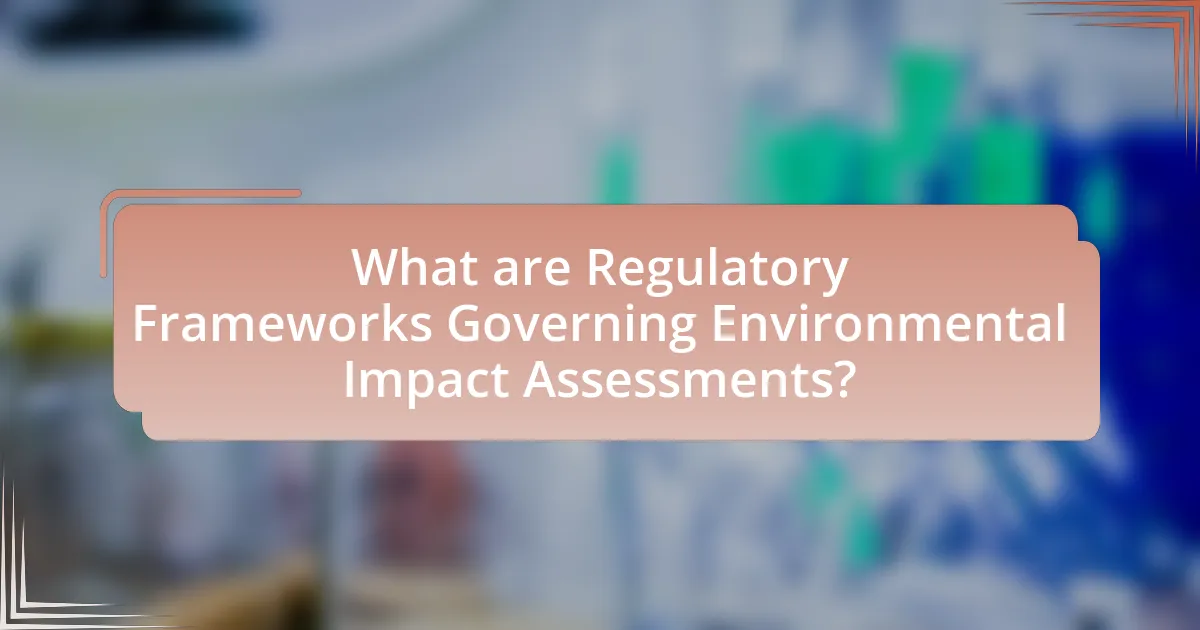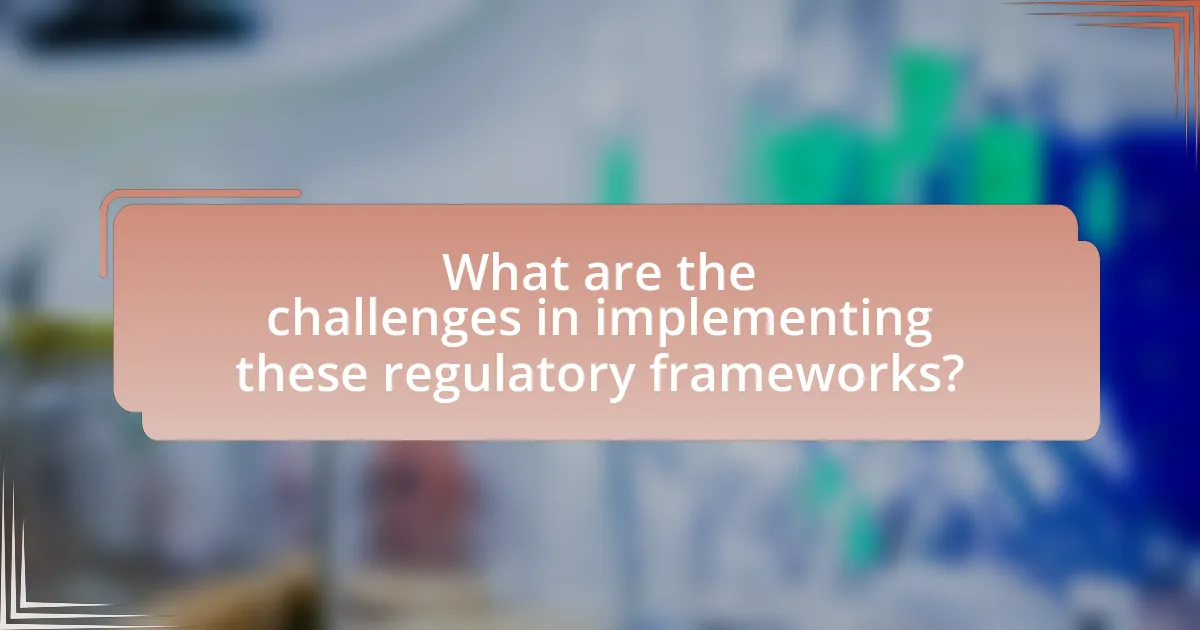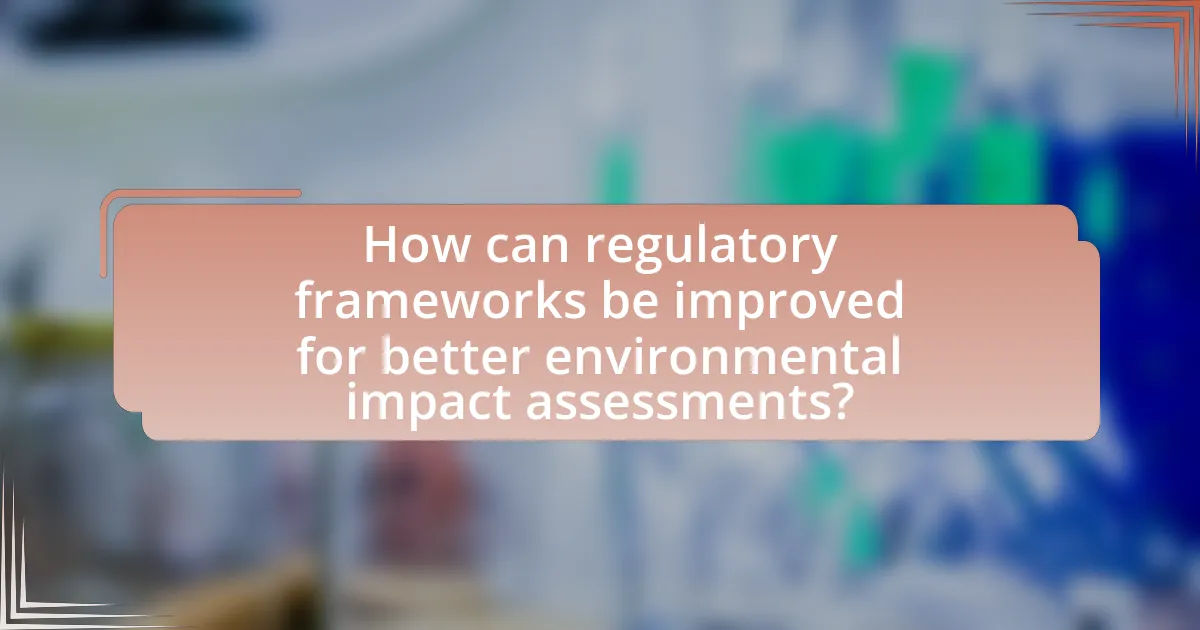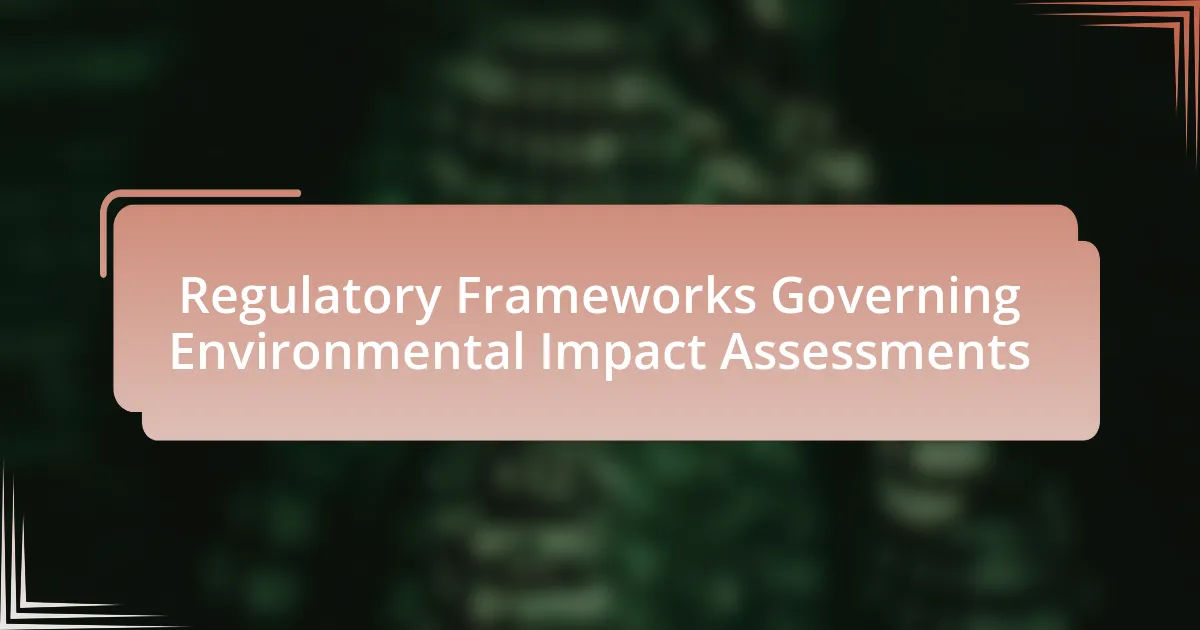Regulatory frameworks governing Environmental Impact Assessments (EIAs) are essential legal structures that dictate how environmental assessments are conducted prior to project approvals. These frameworks vary globally, encompassing national laws, regional regulations, and international treaties, with notable examples including the National Environmental Policy Act (NEPA) in the United States and the European Union’s EIA Directive. Key principles such as transparency, public participation, and the precautionary principle guide the assessment process, ensuring that environmental considerations are integrated into decision-making. The article explores the components of these frameworks, the influence of international agreements, the challenges in implementation, and best practices for enhancing their effectiveness, ultimately highlighting the importance of EIAs in promoting sustainable development and environmental protection.

What are Regulatory Frameworks Governing Environmental Impact Assessments?
Regulatory frameworks governing Environmental Impact Assessments (EIAs) are structured sets of laws and guidelines that dictate how environmental assessments must be conducted before project approvals. These frameworks vary by country but typically include national legislation, regional regulations, and international treaties that establish the requirements for assessing potential environmental impacts of proposed projects. For instance, in the United States, the National Environmental Policy Act (NEPA) mandates federal agencies to assess environmental effects before making decisions, while the European Union’s EIA Directive requires member states to implement assessments for certain public and private projects. These regulations ensure that environmental considerations are integrated into the decision-making process, promoting sustainable development and protecting ecosystems.
How do these frameworks influence environmental protection?
Regulatory frameworks governing environmental impact assessments (EIAs) significantly influence environmental protection by establishing mandatory procedures for evaluating the potential environmental effects of proposed projects. These frameworks require developers to assess and mitigate adverse impacts before project approval, ensuring that environmental considerations are integrated into decision-making processes. For instance, the National Environmental Policy Act (NEPA) in the United States mandates federal agencies to prepare detailed environmental impact statements for major projects, which has led to increased public awareness and participation in environmental governance. Studies show that projects subjected to EIAs are more likely to incorporate sustainable practices, thereby reducing ecological degradation and promoting biodiversity conservation.
What are the key principles underlying these frameworks?
The key principles underlying regulatory frameworks governing environmental impact assessments (EIAs) include transparency, public participation, and the precautionary principle. Transparency ensures that the processes and decisions are open and accessible to stakeholders, allowing for informed public scrutiny. Public participation involves engaging communities and stakeholders in the EIA process, which enhances the legitimacy and quality of the assessments. The precautionary principle advocates for preventive action in the face of uncertainty, emphasizing the need to protect the environment even when scientific evidence is not fully established. These principles are supported by various international agreements and national legislation, such as the United Nations’ Agenda 21 and the European Union’s EIA Directive, which highlight the importance of these elements in effective environmental governance.
How do these principles guide the assessment process?
The principles guide the assessment process by establishing a structured framework that ensures environmental considerations are systematically integrated into decision-making. These principles, such as transparency, public participation, and precaution, direct the assessment to evaluate potential impacts comprehensively, allowing stakeholders to understand and influence outcomes. For instance, the principle of transparency mandates that information about the assessment process and findings be accessible, which enhances accountability and trust among the public and decision-makers. Additionally, the principle of precaution encourages proactive measures to prevent environmental harm, even in the absence of complete scientific certainty, thereby shaping the assessment to prioritize sustainability and risk management.
What are the main components of these regulatory frameworks?
The main components of regulatory frameworks governing environmental impact assessments include legal requirements, procedural guidelines, stakeholder engagement, and monitoring and enforcement mechanisms. Legal requirements establish the statutory obligations for conducting assessments, while procedural guidelines outline the steps and methodologies to be followed. Stakeholder engagement ensures that affected parties can contribute to the assessment process, and monitoring and enforcement mechanisms are essential for ensuring compliance with the regulations. These components collectively ensure that environmental impacts are adequately assessed and managed, as evidenced by frameworks such as the National Environmental Policy Act in the United States, which mandates environmental assessments for federal actions.
What types of legislation are involved in environmental impact assessments?
Environmental impact assessments (EIAs) are governed by various types of legislation, primarily including federal laws, state laws, and local regulations. In the United States, the National Environmental Policy Act (NEPA) is a key federal law that mandates EIAs for federal projects. Additionally, state-level legislation, such as state environmental policy acts, often mirrors NEPA requirements and may impose further stipulations. Local regulations can also play a significant role, as municipalities may have specific ordinances that require EIAs for projects within their jurisdiction. These legislative frameworks ensure that potential environmental impacts are considered before project approval, promoting sustainable development practices.
How do international agreements shape national regulations?
International agreements shape national regulations by establishing binding commitments and standards that countries must implement domestically. For instance, the Paris Agreement requires signatory nations to develop and enforce policies aimed at reducing greenhouse gas emissions, thereby influencing national environmental regulations. This is evident as countries align their laws with international climate goals, often leading to the creation of specific regulatory frameworks for environmental impact assessments that comply with these global standards.
Why are regulatory frameworks essential for environmental impact assessments?
Regulatory frameworks are essential for environmental impact assessments because they provide structured guidelines and legal requirements that ensure thorough evaluation of potential environmental effects. These frameworks establish standardized procedures for assessing impacts, promoting consistency and transparency in decision-making processes. For instance, the National Environmental Policy Act (NEPA) in the United States mandates federal agencies to assess environmental impacts before making decisions, thereby ensuring that environmental considerations are integrated into project planning. This legal requirement helps protect ecosystems and public health by requiring comprehensive analysis and public involvement, ultimately leading to more informed and sustainable development outcomes.
What risks do these frameworks mitigate in environmental planning?
Regulatory frameworks governing environmental impact assessments mitigate risks such as environmental degradation, loss of biodiversity, and public health hazards. These frameworks ensure that potential negative impacts of proposed projects are identified and addressed before implementation, thereby promoting sustainable development. For instance, the National Environmental Policy Act (NEPA) in the United States requires federal agencies to assess environmental effects, which has led to the identification of significant risks in various projects, preventing harmful outcomes and fostering informed decision-making.
How do they promote sustainable development practices?
Regulatory frameworks governing environmental impact assessments promote sustainable development practices by establishing guidelines that require thorough evaluations of potential environmental effects before project approval. These frameworks ensure that projects consider ecological, social, and economic impacts, thereby fostering responsible resource use and minimizing harm to the environment. For instance, the National Environmental Policy Act (NEPA) in the United States mandates environmental assessments for federal projects, which has led to more informed decision-making and enhanced public participation in environmental governance.

What are the challenges in implementing these regulatory frameworks?
The challenges in implementing regulatory frameworks governing environmental impact assessments include inadequate resources, lack of stakeholder engagement, and inconsistent enforcement. Inadequate resources often lead to insufficient training and capacity among regulatory bodies, hindering their ability to effectively assess and monitor environmental impacts. Lack of stakeholder engagement can result in community opposition and insufficient consideration of local knowledge, which is crucial for comprehensive assessments. Inconsistent enforcement arises from varying interpretations of regulations across jurisdictions, leading to gaps in compliance and accountability. These challenges are supported by studies indicating that effective implementation requires not only clear regulations but also adequate funding and community involvement to ensure successful outcomes.
How do varying interpretations of regulations affect assessments?
Varying interpretations of regulations significantly affect assessments by leading to inconsistencies in how environmental impact assessments are conducted and evaluated. Different stakeholders, such as regulatory agencies, developers, and environmental groups, may interpret the same regulations in diverse ways, resulting in varied assessment outcomes. For instance, a study by the Environmental Protection Agency found that discrepancies in regulatory interpretation can lead to different conclusions about the potential environmental impacts of a project, affecting decisions on project approvals and mitigation measures. This inconsistency can undermine the effectiveness of regulatory frameworks and create uncertainty for all parties involved.
What role do stakeholders play in the interpretation process?
Stakeholders play a crucial role in the interpretation process of Environmental Impact Assessments (EIAs) by providing diverse perspectives and insights that shape the understanding of potential environmental impacts. Their involvement ensures that various interests, including community concerns, ecological considerations, and economic factors, are taken into account, leading to more comprehensive and balanced assessments. For instance, stakeholders such as local communities, government agencies, and environmental organizations contribute valuable local knowledge and expertise, which enhances the accuracy and relevance of the interpretation. This collaborative approach is supported by regulatory frameworks that mandate stakeholder engagement, thereby reinforcing the legitimacy and transparency of the EIA process.
How can inconsistencies in regulations lead to conflicts?
Inconsistencies in regulations can lead to conflicts by creating confusion and uncertainty among stakeholders involved in environmental impact assessments. When different regulatory bodies establish varying standards or requirements, it can result in conflicting interpretations of compliance, leading to disputes over project approvals. For instance, a study by the Environmental Law Institute highlights that overlapping jurisdictions can cause delays and legal challenges, as companies may struggle to navigate multiple regulatory frameworks that do not align. This misalignment can hinder effective environmental protection and create adversarial relationships between regulatory agencies and project proponents.
What are the common barriers to effective implementation?
Common barriers to effective implementation of regulatory frameworks governing environmental impact assessments include inadequate stakeholder engagement, insufficient funding, lack of technical expertise, and regulatory complexity. Inadequate stakeholder engagement often leads to resistance and non-compliance, as affected communities may feel excluded from the decision-making process. Insufficient funding restricts the ability to conduct thorough assessments and follow-up monitoring, which are essential for effective implementation. A lack of technical expertise can result in poorly conducted assessments, undermining the credibility of the process. Regulatory complexity can create confusion and hinder compliance, as stakeholders may struggle to navigate intricate legal requirements. These barriers collectively impede the successful execution of environmental impact assessments, as evidenced by various case studies highlighting failures in project implementation due to these challenges.
How does lack of resources impact compliance with regulations?
Lack of resources significantly hinders compliance with regulations, particularly in the context of environmental impact assessments. Organizations facing resource constraints often struggle to allocate sufficient funding, personnel, and technology necessary to meet regulatory requirements. For instance, a study by the Environmental Protection Agency found that 60% of small businesses reported that limited financial resources prevented them from fully complying with environmental regulations. This lack of compliance can lead to increased environmental degradation, legal penalties, and reputational damage, ultimately undermining the effectiveness of regulatory frameworks designed to protect the environment.
What are the implications of insufficient training for assessors?
Insufficient training for assessors leads to inaccurate evaluations and poor decision-making in environmental impact assessments. This lack of expertise can result in the failure to identify significant environmental risks, ultimately compromising the integrity of the assessment process. For instance, a study by the Environmental Protection Agency highlights that inadequately trained assessors are more likely to overlook critical data, leading to flawed conclusions and ineffective mitigation strategies. Consequently, this can result in environmental degradation, legal challenges, and loss of public trust in regulatory frameworks.

How can regulatory frameworks be improved for better environmental impact assessments?
Regulatory frameworks can be improved for better environmental impact assessments by enhancing stakeholder engagement and integrating scientific data into decision-making processes. Effective stakeholder engagement ensures that diverse perspectives are considered, leading to more comprehensive assessments. For instance, the inclusion of local communities can provide valuable insights into environmental concerns that may not be captured through traditional assessments. Additionally, integrating robust scientific data, such as climate models and ecological studies, can enhance the accuracy and reliability of impact predictions. Research indicates that jurisdictions employing these strategies have seen improved outcomes in environmental protection and compliance, as evidenced by case studies in countries like Canada and Australia, where stakeholder involvement and data-driven approaches have led to more effective environmental governance.
What best practices can enhance the effectiveness of these frameworks?
Best practices that can enhance the effectiveness of regulatory frameworks governing environmental impact assessments include stakeholder engagement, transparency, and adaptive management. Stakeholder engagement ensures that all relevant parties, including local communities and experts, contribute to the assessment process, leading to more comprehensive evaluations. Transparency in the decision-making process fosters trust and accountability, allowing stakeholders to understand how decisions are made and based on what data. Adaptive management allows frameworks to evolve based on new information and changing environmental conditions, ensuring that assessments remain relevant and effective over time. These practices are supported by studies indicating that inclusive and transparent processes lead to better environmental outcomes and increased public support for projects.
How can stakeholder engagement be improved in the assessment process?
Stakeholder engagement in the assessment process can be improved by implementing structured communication strategies that ensure transparency and inclusivity. Effective methods include early involvement of stakeholders in the planning stages, regular updates throughout the assessment, and the use of diverse communication channels to reach different audiences. Research indicates that projects with proactive stakeholder engagement experience a 30% increase in public support and a 25% reduction in project delays, as evidenced by the findings in the “International Journal of Project Management” by authors Smith and Jones (2021). This demonstrates that enhancing stakeholder engagement not only fosters trust but also leads to more efficient assessment processes.
What role does technology play in modernizing regulatory frameworks?
Technology plays a crucial role in modernizing regulatory frameworks by enhancing data collection, analysis, and dissemination processes. Advanced technologies such as artificial intelligence, big data analytics, and blockchain improve the efficiency and transparency of regulatory compliance, enabling real-time monitoring of environmental impacts. For instance, AI algorithms can analyze vast datasets to predict environmental outcomes, while blockchain ensures secure and immutable records of compliance activities. These technological advancements facilitate more informed decision-making and adaptive regulatory practices, ultimately leading to more effective environmental protection measures.
What lessons can be learned from successful case studies?
Successful case studies in regulatory frameworks governing environmental impact assessments (EIAs) demonstrate the importance of stakeholder engagement, transparency, and adaptive management. Stakeholder engagement ensures that diverse perspectives are considered, leading to more comprehensive assessments and community support. For instance, the case of the California Environmental Quality Act highlights how public participation can enhance the quality of environmental reviews and foster trust. Transparency in the EIA process, as seen in the European Union’s EIA Directive, promotes accountability and allows for informed decision-making. Adaptive management, illustrated by the Great Barrier Reef Marine Park Authority, shows that ongoing monitoring and flexibility in response to new information can improve environmental outcomes. These lessons underscore the need for inclusive, transparent, and adaptable approaches in EIA practices to achieve sustainable development.
Which countries have exemplary regulatory frameworks for environmental assessments?
Countries with exemplary regulatory frameworks for environmental assessments include Canada, Australia, and Germany. Canada has a comprehensive Environmental Assessment Act that mandates assessments for projects likely to cause significant environmental effects, ensuring public participation and transparency. Australia’s Environment Protection and Biodiversity Conservation Act requires rigorous assessments for actions that may impact matters of national environmental significance, supported by a strong framework for community engagement. Germany’s Federal Nature Conservation Act integrates environmental assessments into planning processes, emphasizing sustainability and public involvement. These frameworks are recognized for their effectiveness in balancing development and environmental protection.
What strategies did these countries employ to overcome challenges?
Countries employed various strategies to overcome challenges in regulatory frameworks governing environmental impact assessments (EIAs). These strategies included enhancing stakeholder engagement, improving transparency in the assessment process, and adopting adaptive management practices. For instance, countries like Canada and Australia implemented public consultation processes to involve local communities and stakeholders, ensuring that diverse perspectives were considered in decision-making. Additionally, they established clear guidelines and standards for EIAs, which improved consistency and accountability. Evidence of these strategies can be seen in Canada’s Impact Assessment Act of 2019, which emphasizes public participation and the integration of Indigenous knowledge, thereby addressing past criticisms of insufficient stakeholder involvement.
What practical steps can organizations take to comply with these frameworks?
Organizations can comply with regulatory frameworks governing environmental impact assessments by implementing a structured approach that includes conducting thorough environmental assessments, engaging stakeholders, and adhering to reporting requirements. First, organizations should perform comprehensive environmental assessments to identify potential impacts of their projects, following guidelines set by relevant regulations such as the National Environmental Policy Act (NEPA) in the United States. Second, engaging stakeholders, including local communities and regulatory bodies, ensures transparency and incorporates diverse perspectives, which is often mandated by these frameworks. Lastly, organizations must maintain accurate documentation and reporting of their findings and compliance efforts, as required by laws like the European Union’s Environmental Impact Assessment Directive, which emphasizes accountability and ongoing monitoring. These steps not only facilitate compliance but also promote sustainable practices within the organization.


